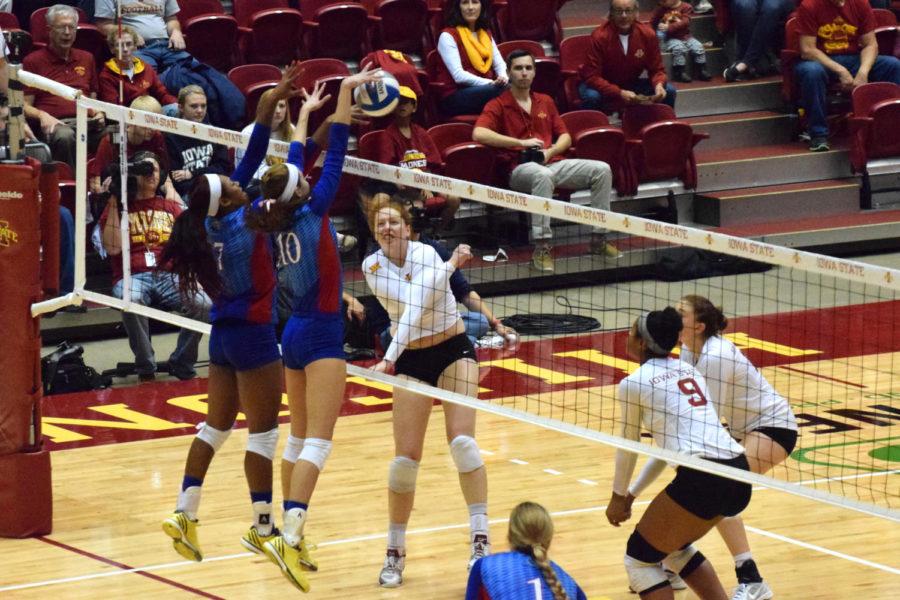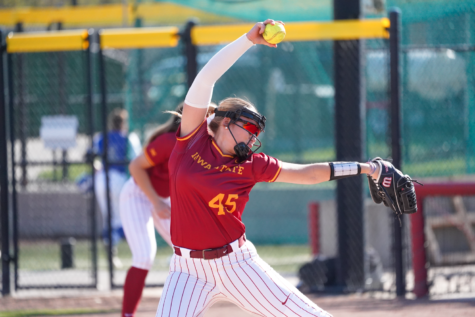Efficiency problems plague ISU volleyball in Big 12 play
Junior right side hitter Mackenzie Bigbee gets blocked by Kansas outside hitter Tiana Dockery (left) and middle blocker Tayler Soucie (right) on Oct. 22.
October 23, 2014
Not all statistics are created equal.
There is perhaps no better example of that maxim in collegiate volleyball in 2014 than the ISU volleyball team (10-7, 2-4 Big 12).
Despite leading the conference in average kills per set at 14.03, average assists per set at 13.31 and average digs per set at 16.43, Iowa State still finds itself at 2-4 in Big 12 play and on the outside looking in at the top 25 national rankings.
“Some categories matter more than others,” said ISU volleyball coach Christy Johnson-Lynch.
Kills equal points. Assists lead directly to kills, which lead directly to points. Digs are generally regarded as the most prominent defensive stat, as they indicate a defensive stop and allow for another offensive attack inside the same point.
The prominence of these traditional statistical categories and their seemingly obvious correlation to victories makes the ISU lack of success that much more baffling.
Johnson-Lynch explained the disconnect between the impressive traditional stats her team has amassed this year and why those numbers are not translating into wins.
“If you can lead in hitting percentage, you are probably winning your conference,” Johnson-Lynch said. “Hitting percentage is usually the best direct correlation to wins and losses.”
Hitting percentage measures the number of attacks a team attempts against the number of attacks that find home on the opposite side of the net, which then lead to points on the scoreboard.
Much the same as sports like basketball and baseball, the total statistical output of a volleyball team inside the lines of play matters far less than how efficiently that output is achieved.
“We can kill the ball but it might take us too many rallies to kill that ball,” Johnson-Lynch said. “Our hitting percentage is a little bit low and we are allowing our opponents to hit too high. That is where I see the disconnect.”
Advanced statistics that measure efficiency are sweeping the sports landscape at both collegiate and pro levels, which is changing the way coaches and teams are approaching the game.
That notion was evidenced perfectly by Johnson-Lynch as she explained which statistical categories actually have the greatest affect on the outcome of a match.
“The categories that matter a lot are going to be hitting percentage, service aces and blocks per game,” Johnson-Lynch said.
Iowa State is seventh in hitting percentage at .220 and sixth in opposing hitting percentage at .200.
The Cyclones are also sixth in service aces, scoring 1.16 per set, and stand at seventh in blocks, tallying 2.13 per set.
Consequently, Iowa State currently occupies a tie for sixth in the Big 12 standings with West Virginia.
The silver lining of the disappointing results thus far for the Cyclones is that they know exactly why they are struggling and they have nine conference matches left to correct their issues.
The greatest of Iowa State’s concerns are unforced errors, which are the natural enemy of efficient play in any sport.
“We have so many opportunities, and we get the ball up so many times,” said sophomore outside hitter Ciara Capezio. “Yet, over and over again with those long rallies, we tend to make errors.”
The errors are not player or position specific, which means they are an issue permeating the entirety of the ISU team, as Johnson-Lynch explained.
“It is not just one person. You come at it from a lot of different angles,” Johnson-Lynch said. “Some of it is ball handling. If you pass the ball to the setter in a good spot, she can run a better offense. Some of it is setting – making sure our setters understand who to set in what situation. Some of it is attack decisions.”
Iowa State’s 2-4 record is not indicative of the potential the team has.
Iowa State has lost two matches – one in four sets at Texas Christian early in the season and another at Texas Tech in five sets Oct. 18 – in which small improvements during a few crucial points of one particular set would likely have meant wins instead of losses.
Junior right side hitter Mackenzie Bigbee said those abbreviated but paramount strings of points in matches are where the team has slipped, but also where it is focusing the majority of its efforts in practice.
“A lot of times in those games we will make multiple errors,” Bigbee said. “We will hit a few too many balls out, miss a few too many serves and those are the difference-making plays.”
The Cyclones must address their concerns quickly because at 2-4 with the halfway point of the conference schedule fast approaching, the margin for error is becoming smaller with every passing match.

















